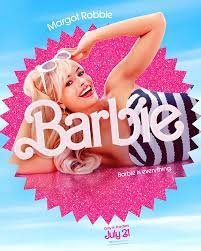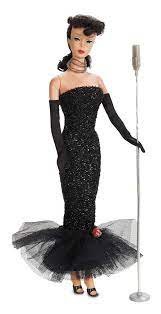Barbie Before Pink.
My Barbie “Bubble Cut” Model #850 1963
Having just experienced the Summer ‘23 Cine-phenomenon of Oppenbarbie (Or Barbenheimer, I suppose, depending on your order of smash viewing,) I was struck by how very little the much-lauded all-pink Barbie Movie experience jelled with my own girlhood memories. Things started out well enough, with an almost apocalyptic opening sequence destruction of a pre-Barbie baby doll world where little girl’s fantasy play revolved around mimicking motherhood and domesticity. I remember hating baby dolls and all that cooing, tucking-in and tea party jazz. My toy world consisted of crayons, building sets and steam shovels (thank you, Mike Mulligan) and in 1963, Barbie.
Introduced by Mattel entrepreneur, Ruth Handler (and husband, Eliot) in 1959 and named for their daughter, Barbara, Barbie first made her way into the hearts of American girls in a chic black and white maillot swimsuit, sunglasses and heels. Her poodle-banged, high ponytail was available in black, blonde, or, swoon, titian.
Ruth Handler modeled Barbie on a German post-war tough gal, Bild Lily, and was inspired by watching her daughter play with paper dolls; play that involved the sheer fun of dressing up. One doll, many ensembles. Easy in paper, but, “aha!” thought Handler, so potentially profitable as a way to extend the purchase of one doll into a collection of new outfits every birthday, holiday and with a little girl’s saved weekly allowance. Positioned as a “teen-aged fashion model,” Barbie took dolls uptown.
Patent Leather Barbie® Case
My first Barbie was a Christmas present received at age six. She was, as I remember, a blonde bubble-cut beauty with pale lips and a red one-piece swimsuit. She lived in an elegant black patent leather case where her growing wardrobe of fashions hung on tiny monogrammed hangers while shoes and gloves (and bags and hats together with the occasional poodle) occupied the case’s drawer. That first holiday haul brought several classic outfits as well — all hand-sewn of gorgeous and properly scaled materials accessorized with perfect attention to detail. As I recall, Santa had a real eye for what a chic woman needed in her capsule wardrobe and provided things for evening (Solo in the Spotlight) career (Commuter Set) and weekend wear (Suburban Shopper.)
SOLO IN THE SPOTLIGHT BARBIE®
Busy Gal Barbie®
As time passed, my Barbie’s wardrobe came to contain “After Five,” a stunning black and white silk dress and hat ensemble, “Black Magic” a sheer coat and sheath dress, “Red Flare” a velvet hat and coat and a “Nighty Negligee” sleepwear duo with full-length robe and gown in sheer pale pink organza. Barbie might have been a “Registered Nurse” (with crisp white uniform, hat and blue wool cape lined with red silk) a “Ballerina” or even a bride “Wedding Day.” In my fantasy world, however, Barbie was a “Busy Gal” heading off to her office in a Chanel-inspired suit with portfolio under her arm.
BLACK MAGIC BARBIE®
NURSE BARBIE®
My Barbie world was decidedly NOT about Ken, or Midge/Christie/Francie et al girl-talk, pink Dream Houses or pink snowmobiles, however. In fact, save for the gossamer negligee, my Barbie wore silk, tweed and linen in any color BUT pink. My Barbie (at least in my mind) was not a teenager. She was an independent woman of means who had a career, was an accomplished skater, who sang at the Cafe Carlyle for fun and hurried off every weekday to Madison Avenue. My Barbie was Mrs. Mazel. Jackie Kennedy. Or Audrey Hepburn. Or even my Aunt Harriet. Or more importantly, I suppose, my mom.
‘67 TWIST N TURN BARBIE®
It wasn’t until the 1970’s after all cultural hell had broken loose that Barbie’s world plunged toward the mod, fab and polyester. And while she still sported an impossible (though now “Twist n Turn”) figure, her outfits trended toward hippie and flower power. Go Go boots and fun fur. Out with Frank Sinatra, Mel Tormé and even Elvis. In with The Beatles, The Doors, The Stones and Diana Ross. Jean Shrimpton and Twiggy in Carnaby Street minis and bell-bottoms headlined Diana Vreeland’s Vogue and women had the pill. But Barbie, poor Barbie was a mess.
BRIDGE AND TUNNEL BARBIE®
Despite all that liberation and loosening of social constraints, In the 1980’s and 1990’s (where we meet Margot Robbie’s screen image of our girl,) Barbie seems to have descended into an odd, decidedly alt-feminist pink limbo where a most clichéd color replaced what had once been cool, confident elegance. Barbie’s life seemed to be all fun, all casual, and all, well, pink. Barbie’s world of Dream Houses, convertibles and power boats, hip huggers, long, lux hair and leg warmers. Suddenly, Jackie Kennedy looked more like Dolly Parton (not that there’s anything wrong with Dolly Parton) and her chic, uptown aesthetic looked decidedly more bridge and tunnel.
BARBIE DREAMHOUSE
Curious. And I suppose entirely consistent with how a great big growing, global brand is managed and innovated by trends and forecasts (and male executives) rather than by an entrepreneur’s decidedly womanly (and empowered) vision. A doll whose original ethos gave little girls a whole new way to think about their future ironically seemed to plunge —in the midst of a feminist revolution — into pink polyester purgatory. (But, to be fair, fashion was at a bit of a low ebb, too. Plus TV Dinners.)
Oh, and certainly, things changed in Barbie world, perhaps as a response to a vast feminist and cultural uproar about a mostly white, booby, flirty, blonde, sexy pink princess. The 1990’s and early 2000’s saw a broader range of “ethnic” Barbies as well as the “Professional” Barbie editions (Astronaut, Surgeon, “Pet-Doctor,” Computer Engineer, Candidate, and News Anchor among many others.)
PANTSUIT POLITICAL CANDIDATE BARBIE®
But still, the pink persisted. And Surgeon Barbie wears a mini skirt set of scrubs. Or at least she did in 1973, and Astronaut Barbie in 1986 stands on the Moon in a pink space suit (with Renaissance Leg-o-Mutton sleeves, so practical for those Lunar nights.) Today, checking the Walmart toy site, I found most Barbies in pink with names like “Totally Hair Fashion,” “Fashionista,” and “Extra-Fancy with Extra Long Blond Hair.” There appears to be a nod to continuing feminism, however with dolls in the Barbie Careers series including the “Baby Doctor” model. (Perhaps “obstetrician” didn’t test well?) There is also an interesting “Inspiring Women” series including Ida B. Wells, Madame C.J. Walker, Bessie Coleman, Dr. Jane Goodall (with chimp,) Billie Jean King, Sally Ride, Rosa Parks and Eleanor Roosevelt. One wonders, however, if the brand won’t call a physician doll an obstetrician how might it interest a little girl consumer in a doll modeled after a 19th century entrepreneur she’s probably never heard of? I suspect the “Inspiring Women” series is actually marketed toward those who go in for the now re-issued vintage reproduction Barbies. Women, in other words, like me who seriously considered shelling out $4,000 for a never-removed-from package collection of 42 vintage Barbie outfits from the 1960’s. But I digress. (And I didn’t.)
IDA B. WELLS BARBIE®
So, what’s all this got to do with the new and highly praised Barbie movie? I guess it’s an exploration and maybe explanation of why the film doesn’t exactly jive with my decidedly pre-Title IX 66 year old memories.
Because I was on to other things by the time Barbie went shocking pink, my memories of her were different. My Barbie didn’t giggle. She didn’t break out into convulsive dancing nor did she have to be explained or “positioned” as a Barbie-does-Everything.
My Barbie (who probably preferred being called Barbara) sang like Julie London and looked like Grace Kelly. She was her own woman. And while I thoroughly enjoyed Greta Gerwig’s lush Barbieland caper, it felt, well, like a paean to a Barbie universe different from the one I knew.












